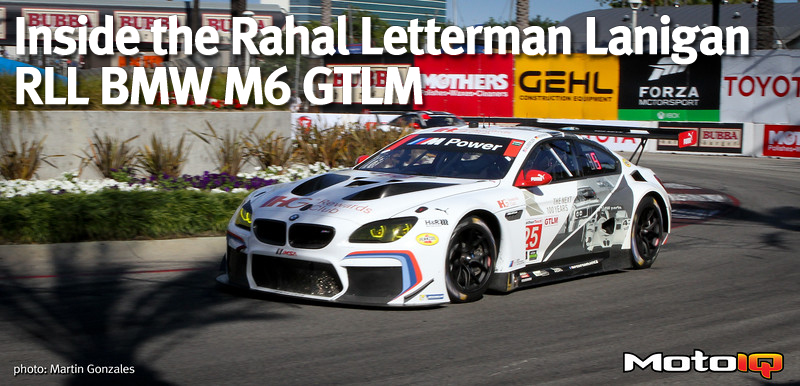
One of our traditions while at the Long Beach Grand Prix, is to get a close look at the latest factory BWM racers with the Rahal Letterman Lanigan team. The latest car that BMW is campaigning is an M6 in IMSA’s GTLM class.
GTLM is IMSA’s premiere production car class which has a pretty open homologation. The cars are limited to around 500 hp with a 2745 lb minimum weight. A wide variety of modifications are allowed depending on the car. Some cars are homologated with the factory unibody and others can run tube frames. Suspension design is pretty open and significant aero mods are allowed within limits.
The main limitation that is closely regulated is power and power to weight. This is enforced with inlet restrictor sizing on most cars. Most car have a maximum inlet diameter and IMSA regulates power though changes is restrictor diameter. This works decently well to keep the racing close even with a wide diversity of engine sizes and types.
The Rahal Letterman Lanigan M6 is a great example of a car built to the technical limit of the class rules and it is a very fascinating car. Let’s get a closer look.
 The BMW M6 actually starts off with a production body in white as it’s homologation limits it to run the factory unibody. Believe it or not it also uses a completely stock engine!
The BMW M6 actually starts off with a production body in white as it’s homologation limits it to run the factory unibody. Believe it or not it also uses a completely stock engine! The engine is a bone stock 4.4 liter BMW M power S63 V8. The engine with the restrictor actually makes less power than the unrestricted 560 hp stock engine in the M6. The engine management is tweaked to take advantage of the OEM spec Garrett GT2260 ball bearing turbos to make as much torque as possible without exceeding the power limit.
The engine is a bone stock 4.4 liter BMW M power S63 V8. The engine with the restrictor actually makes less power than the unrestricted 560 hp stock engine in the M6. The engine management is tweaked to take advantage of the OEM spec Garrett GT2260 ball bearing turbos to make as much torque as possible without exceeding the power limit.The BMW S63 engine is not limited by restrictors but rather by an IMSA approved and monitored ECU controled boost map that is intended to keep power to 500 hp.
 The engine is so stock it uses stock pistons, rods and crankshaft, cams, heads, turbos and valvetrain. The engine is drysumped to ensure lubrication that the high G loads slicks, awesome suspension and aero can produce.
The engine is so stock it uses stock pistons, rods and crankshaft, cams, heads, turbos and valvetrain. The engine is drysumped to ensure lubrication that the high G loads slicks, awesome suspension and aero can produce.The charge piping is not stock and is shaped from carbon to get the smoothest flow possible. The stainless exhaust system goes along the firewall and out the sides of the car where they help with the aerodynamics. More on that later.
 A very interesting feature of the S63 engine is that the flow through the cylinder heads is reversed. Typically most V engines have the intake manifold in the V of the engine and the exhaust manifolds on the sides of engine outside the V.
A very interesting feature of the S63 engine is that the flow through the cylinder heads is reversed. Typically most V engines have the intake manifold in the V of the engine and the exhaust manifolds on the sides of engine outside the V.The S63 reverses this so that twin scroll turbos can be used. To take advantage of a twin scroll exhaust housing, the pulses to the turbine have to be separated by as many degrees of crank rotation as possible. This normally requires a 180 degree crankshaft on a V8. A 180 degree crank basically turns a V8 into two 4 cylinder engines which allows good pulse separation. The disadvantage of a 180 degree crank is that it is not as smooth.
By running the turbos in the engine’s V, each side of the twin scroll exhaust housing can be fed across the cylinder banks to maintain pulse separation as shown in the above picture. In this way the pulse conversion of a 180 degree crankshaft can be had with the smoothness of a conventional crank!
Twin scroll turbos when paired with a properly designed exhaust manifold typically spool at least 25% faster and at a much lower rpm. By maintaining good pulse separation, the engine is less sensitive to exhaust reversion caused by turbine induced backpressure which can allow for more aggressive cam timing at low and mid rpm which can help power in these areas of the powerband. Interesting engineering here!
 What is not stock for sure are the heat exchangers for the coolant and the intake charge air. They have much more capacity and every bit of air going through them is managed for aerodynamic reasons through extensive carbon ductwork. The stock M6 intercoolers are water to air but the race car uses air to air heat exchangers.
What is not stock for sure are the heat exchangers for the coolant and the intake charge air. They have much more capacity and every bit of air going through them is managed for aerodynamic reasons through extensive carbon ductwork. The stock M6 intercoolers are water to air but the race car uses air to air heat exchangers.


